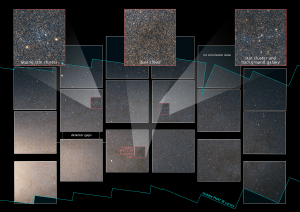Blog
WFIRST Light
5 January 2020
 NASA, STScI, and B. F. Williams (University of Washington)
NASA, STScI, and B. F. Williams (University of Washington)When the Hubble Space Telescope was launched in 1990, it transformed the way we viewed the universe. As a space telescope, it was able to view the heavens without the distortion of Earth’s atmosphere. But while Hubble has served humanity well for the last three decades, our technology has come a long way since then. Thus new space telescopes are being developed that will extend Hubble’s view of the sky.
One of these is the Wide Field Infrared Survey Telescope (WFIRST). Like Hubble, it can view the cosmos at near-infrared wavelengths. But unlike Hubble, it has a much wider field of view. Many telescopes are designed to capture a high-resolution image of a small apparent area. The Hubble, for example, captures an area about a hundredth the apparent size of the Moon. That’s about the size of a grain of sand held at arm’s length.
With traditional telescope designs, higher resolution means observing a smaller area. You have to trade one for the other. But modern designs such as WFIRST can do both, capturing a much wider area at an equal or better resolution. Because of this, WFIRST will be able to capture the equivalent of more than 100 Hubble images in a single image.
Recently the WFIRST team demonstrated this in a simulation of how the telescope could create an image of the Andromeda galaxy. In 2015, the Hubble telescope created a high-resolution image of a portion Andromeda. It showed us details in the galaxy we’ve never seen before. But it was an intensive effort that required Hubble to take more than 400 images. These had to be stitched together to create a single large image of Andromeda. What Hubble captured in 400 images, WFIRST could do in 18.
In terms of the viewing area, WFIRST will be the equivalent of a hundred Hubble telescopes. It will be able to capture images at Hubble resolution, but a thousand times faster. Just as Hubble changed our view of the universe, so could WFIRST.
WFIRST is scheduled to launch sometime in the mid 2020s.